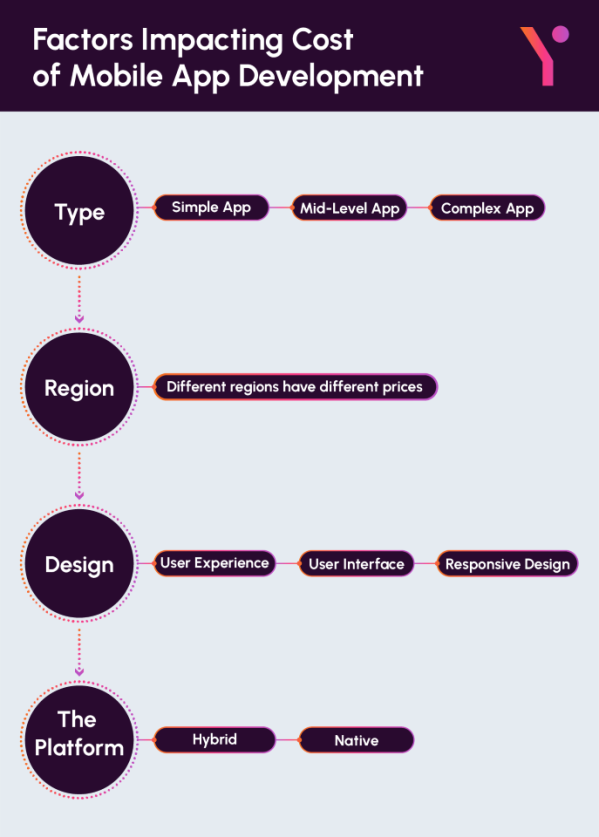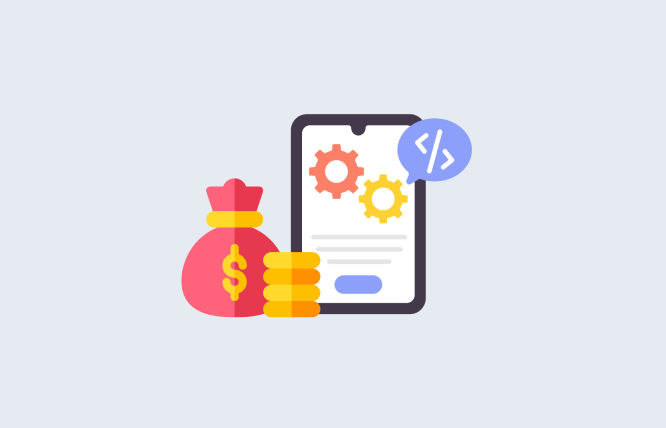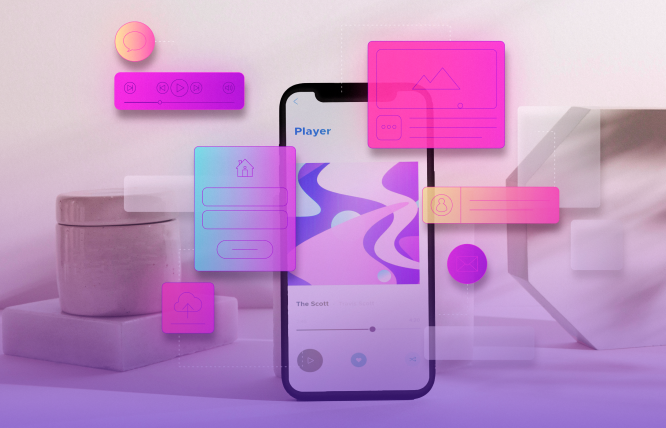Getting a mobile app created for your organisation is crucial and businesses all around the world are investing in these applications. According to a study conducted by Statista, the mobile app revenue is set to increase from $318 billion in 2020 to over $600 billion in 2025.
Businesses understand the importance of developing an app which is evident to see if you look at the third quarter of 2022 and how users spent $21.2 billion on the Apple store alone. These stats make it obvious that investing in mobile application development is essential, but how much will this investment be and what goes into the development of a mobile application?
See what your app could cost — and start building today!
The cost of building an app depends on the app’s complexity.

| App Type | Estimate Cost | Development Time |
| Simple App Development | $10,000 to $60,000 | 1-3 months |
| Mid-Level App Development | $60,000 to $150,000 | 3-6 months |
| Complex App Development | From $300,000 onwards | 9+ months |
In this article we will discuss how much does it cost to develop a mobile app, all the aspects of mobile development costs and the factors that can take the prices up. Keep reading to get a semblance of how much you might need to spend on a mobile application if you do it in house or opt for an app development company.
How Much Does it Cost to Develop a Mobile App: An Insider’s Guide
There is no fixed amount when trying to figure out how much does it cost to develop a mobile app. A number of factors come into play when trying to decode mobile app development costs. Let’s take a deep dive into each of these factors and how much it can cost an organisation.
The Anatomy of Cost: Factors That Influence Mobile App Development Expenses
There are 4 major factors that can impact the cost of a mobile application. These factors include the type, region, design, and the platform used to develop the application. Each of these factors are then broken down into sub-categories which can impact the price accordingly. The following chart will show you an example of these sub-categories.
Platform Predicament: Navigating the iOS vs. Android Dilemma
The first step to mobile app development is deciding whether you want an iOS application or an android application, or maybe even both. IOS, Android and Hybrid app developers will have different timelines and costs associated and it all boils down to the type of application that would benefit your business the most.
Native applications offer better performance and access to device features, as well as offering a seamless user experience. On the other hand, hybrid apps might not have the same level of functionality, but this method offers faster development times and lower costs as only one resource is required to create the application for all platforms.
Depending on the organisational requirements and priorities, you can choose one of the two options to make a choice and start developing. You can either opt for the best hybrid app development, hire an iOS developer or hire an android developer.
Cracking Complexity: Understanding How Features Shape Costs
An application is based on the features it offers. The more features an application has, the more costly it potentially is. Features and functionalities can include payment gateways to API integrations. To summarise, there are 3 levels of features that an application can have, these include; simple apps, mid-level apps and complex apps.
Simple Apps:
These apps include the bare minimum that any application needs to function. They have low tech screens and necessary UI solutions without any added benefit.
Price Range
Approximately $5,000 – $30,000.
Mid-Level Apps:
Taking it a step further we get to mid-level applications. These apps have API integration functionality, with more screens, a custom UI and better features such as real-time messaging.
Price Range
Typically ranges from $30,000 – $70,000.
Complex Apps:
These are known as multi-function applications. They offer advanced features and real-time synchronisation. Complex apps can incorporate chatbots, media processing and enhanced UI animations. This is usually seen in custom android app development.
Price Range
Can cost anywhere from $70,000 – $150,000 or more, depending on the specific requirements and features.
Still Thinking About Building an App? We Know What You Need!
Choosing a type of application depends on the business requirements. Bear in mind, each increased level of application can have a substantial impact on the cost of development and the time to develop.
Design Matters: Investing in User Experience
Design plays a pivotal role in app development, influencing both user experience (UX) and user interface (UI) design. A poorly designed application can leave a negative impression on your user, especially if it is a customer-facing application. Some businesses might not take design into consideration when evaluating cost, but design is essential for a successful app.
Within design there are several sub-categories that each cater to a different level of design, these are UI, UX, and responsive design.
User Experience (UX) Design:
A well-designed UX focuses on understanding user needs, behaviours, and preferences to create intuitive and engaging experiences. Investing in UX design upfront can help identify user pain points, streamline workflows, and optimise navigation, resulting in higher user satisfaction and retention. However, conducting user research, prototyping, and usability testing to iterate on UX designs can add to development costs.
User Interface (UI) Design:
UI design encompasses visual elements such as layout, typography, colour schemes, and interactive components that enhance the app’s aesthetic appeal and usability. A visually appealing and consistent UI contributes to brand identity, builds trust with users, and improves overall user engagement. Crafting custom UI designs and animations tailored to the app’s branding and target audience may require additional design resources and increase development costs.
Responsive Design:
With the proliferation of mobile devices and screen sizes, ensuring a seamless experience across various devices and resolutions is essential. Responsive design adapts the app’s layout and content dynamically to fit different screen sizes, orientations, and devices, providing a consistent experience for users. Implementing responsive design principles may involve additional design work to create adaptable layouts and optimise content for different viewports, potentially impacting development costs.
Let's connect and build an app together!
Design Types and Their Estimated Costs
Basic Design
Basic design involves simple layouts, standard UI elements, and minimal customisations. It’s functional but lacks the polished, custom feel of more advanced designs.
Example
A basic e-commerce app with standard product listing pages and a simple checkout process.
Cost Range
Approximately $2,000 – $10,000.
Custom Design
Custom design includes tailored UI elements, brand-specific color schemes, and unique layouts. It provides a more refined and engaging user experience.
Example
A custom food delivery app with unique branding elements, personalised user dashboards, and an intuitive ordering process.
Cost Range
Typically ranges from $10,000 – $50,000.
High-End Design
High-end design offers advanced features like intricate animations, custom graphics, and a highly intuitive UX tailored to specific user needs. It involves in-depth research and testing to ensure the design meets user expectations.
Example
A high-end travel booking app with dynamic content, immersive visuals, interactive maps, and personalised recommendations.
Cost Range
Can cost anywhere from $50,000 – $150,000 or more, depending on the level of detail and customisation.
App Development Cost by Region
App development rates vary based on where your development partner is located. At FuturByte, we work with global teams, which allows us to offer flexible pricing options without compromising on quality. Here’s a quick breakdown of average hourly rates by region:
|
Region |
Average Hourly Rate (USD) |
|
North America |
$100 – $200 |
|
Western Europe |
$80 – $150 |
|
Eastern Europe |
$30 – $70 |
|
UK |
$90 – $160 |
|
UAE |
$60 – $100 |
FuturByte helps clients make smart decisions by balancing cost with capability. We work with trusted developers in Eastern Europe, Asia, and the UAE to deliver the same quality you’d expect from a North American team — at a fraction of the cost.
Want to know what your app will cost? Try our calculator today!
Cost of Additional App Development Services
Many businesses forget to account for additional services that are essential after development ends. At FuturByte, we offer full-suite support beyond app development to ensure your app thrives in the market. Here’s what to budget for:
|
Service |
Estimated Cost (USD) |
What FuturByte Offers |
|
App Store Optimization (ASO) |
$500 – $2,000 |
Our team crafts high-converting app store listings to boost visibility. |
|
Marketing & Launch Strategy |
$1,000 – $20,000+ |
From pre-launch buzz to post-launch campaigns, we help you create impact. |
|
App Analytics Integration |
$300 – $2,000 |
We integrate tools like Firebase and Mixpanel to give you user insights that matter. |
|
App Store Publishing Fees |
$25 (Google Play) / $99 yearly (iOS) |
We guide you through publishing, ensuring a smooth and compliant launch. |
FuturByte Insight: We believe in full transparency. That’s why we discuss these costs upfront — no hidden charges, no surprises at the end.
How to Reduce App Development Costs
At FuturByte, we don’t just build apps—we help you build them smartly. Here are some of the ways we help clients bring down costs while maintaining quality:
-
Start with an MVP (Minimum Viable Product): We guide you to focus on core features first so you can launch faster, test user response, and scale wisely.
-
Use Cross-Platform Tools like Flutter or React Native: Our developers are pros at using cross-platform frameworks to save time and reduce costs.
-
Reuse Design Components: Our UI/UX team uses modular design systems, reducing the design effort and speeding up development.
-
Use Third-Party Integrations Wisely: Whether it’s Stripe, Firebase, or Google Maps, we help you plug in tools that save months of custom coding.
-
Automate Testing and Deployment: FuturByte integrates automation into our development process to deliver faster and with fewer bugs.
-
Outsource Non-Core Features: We connect you with specialists when needed, so you don’t pay premium rates for niche tasks.
FuturByte’s Promise: We don’t just look at your budget; we help you make the most of it.
Want to know what your app will cost? Try our calculator today!
Building Blocks: Assembling Your Dream Development Team
Once you have decided on the type of application you want and the design you are looking to get, the next step is to assemble a team of professionals. There are a number of options that can be taken when hiring a team. You can either hire a local agency to outsource your development tasks, hire an in-house team or recruit the help of freelancers. Each of these options have their own set of merits.
The following table discusses the pros of each option and how they have an impact on the cost of development.
| Aspect | Local Agency | In-House Team | Freelancers |
| Expertise and Experience | Experienced professionals | Deep domain knowledge | Specialised talent as needed |
| Communication | Seamless collaboration | Direct oversight and management | Flexibility in project scope |
| Services Offered | Comprehensive services | Full control over development process | Task-specific expertise |
| Cost | Higher cost due to overhead expenses | Long-term investment | Lower hourly rates |
| Risk | Reliance on external resources | Initial investment in hiring/training | Dependency on individual availability |
Beyond Development: Navigating Maintenance and Support Costs
Maintenance and support are the fuel that keeps your app going and is often seen as a hidden cost of application development. Maintenance and support involve ongoing tasks such as bug fixes, performance optimisations, feature updates, security patches, and compatibility enhancements. These maintenance services can range from working for mobile web development and custom apps. Here’s how maintenance can impact costs in app development:
Bug Fixes:
As users interact with the app, they may encounter bugs or issues that need to be addressed promptly. Fixing bugs requires developer time and effort, which adds to the overall maintenance costs.
Example
If users report a bug causing crashes on certain devices, fixing this issue might require developer intervention to debug and patch the problem.
Estimated Cost
$500 – $2,000 per month.
Performance Optimisations:
Over time, as the app’s user base grows or new features are added, performance issues may arise. Optimising the app’s performance to ensure smooth operation on various devices and network conditions can require significant development resources and thus increase maintenance costs.
Example
As your app’s user base grows, you might notice slower load times. Optimising the app’s performance to handle increased traffic can involve updates to improve speed and efficiency.
Estimated Cost
$1,000 – $5,000 per month.
Feature Updates:
To remain competitive and meet user expectations, app developers often need to introduce new features or enhancements. Planning, developing, and integrating these updates into the app requires both time and resources, impacting maintenance costs.
Example
To stay competitive, you might decide to add a new feature like social media integration. This update requires planning, development, and integration into the existing app.
Estimated Cost
$2,000 – $10,000 per update.
Security Patches:
With the ever-evolving threat landscape, ensuring the security of the app is paramount. Regularly issuing security patches and updates to address vulnerabilities or emerging threats is essential but can add to maintenance costs, especially if urgent fixes are needed.
Example
In response to a new security threat, you might need to issue a patch to fix vulnerabilities and protect user data.
Estimated Cost
$500 – $3,000 per patch.
Compatibility Enhancements:
As new operating system versions, devices, or third-party services are released, app compatibility may become an issue. Ensuring that the app remains compatible with the latest technologies and platforms may require modifications or updates, contributing to maintenance costs.
Example
When developing an iOS app, you will get frequent iOS updates. To keep your app run smoothly, you will need to update your app to ensure it remains compatible with the latest operating system features.
Estimated Cost
$1,000 – $4,000 per enhancement.
User Support:
Providing ongoing user support, addressing user inquiries, feedback, and complaints, is part of the maintenance process. Allocating resources to handle user support inquiries and ensuring a positive user experience can impact overall maintenance costs.
Example
If your users are facing issues, you will need a dedicated support team that can ensure a positive experience and prompt resolution of any problems they may face.
Estimated Cost
$1,000 – $5,000 per month.
Infrastructure Costs:
Depending on the app’s architecture, there may be ongoing infrastructure costs associated with hosting, server maintenance, data storage, and bandwidth usage. These infrastructure costs contribute to the overall maintenance expenses.
Example
Ongoing expenses can be anything that you demand after the app is built. For instance, you need to include gamification feature into your services app to attract potential customers.
Estimated Cost
$500 – $2,500 per month.
Let's connect and build an app together!
Estimation Essentials: Tools and Techniques for Cost Projections
Once you have decided all the aspects of your mobile app, it is best to start creating an estimation of your project. This can be done by using a number of different tools. These include:
Estimation Templates:
Utilise pre-designed estimation templates or spreadsheets tailored for mobile app development. These templates often include predefined categories such as design, development, testing, and deployment, making it easier to itemise costs and calculate estimates.
Function Point Analysis (FPA):
FPA is a technique used to measure the functionality provided by a software application. By quantifying the features and functionality of the mobile app, FPA helps estimate the effort and cost required for development. Various online tools and calculators are available to perform FPA quickly and accurately.
Feature-Based Estimation:
Break down the mobile app’s features and functionalities into granular components and estimate the cost for each feature individually. This approach allows for more accurate cost projections by considering the complexity and effort required for each feature.
Benchmarking:
Compare the proposed mobile app with similar apps in the market to gauge the level of effort and cost required for development. Analyse competitor apps in terms of features, complexity, user experience, and technology stack to derive comparative cost projections.
Risk Analysis:
Conduct a risk analysis to identify potential risks and uncertainties that may impact the project’s cost. Factor in contingencies and risk mitigation strategies when estimating costs to account for unforeseen challenges or scope changes.
Project Management Tools:
Use project management tools like Jira, Trello, or Asana to track project tasks, milestones, and expenses. These tools provide visibility into project progress and help manage costs effectively throughout the development lifecycle.
Optimising Costs: Strategies for Maximising Value
Mobile app development can be a costly process, but certain strategies can be employed to optimise the costs during the development process. These strategies include:
Prioritise Features
Identify and prioritise essential features that align with the app’s core objectives and user needs. Focus on developing minimum viable product (MVP) features first and consider adding additional features in future updates based on user feedback and analytics.
Iterative Development
Embrace an iterative development approach where the app is developed and released in small, incremental stages. This allows for continuous feedback and refinement, reducing the risk of costly rework and ensuring that resources are allocated efficiently.
Use Open-Source Technologies
Leverage open-source frameworks, libraries, and tools to reduce development costs. Open-source technologies offer robust functionality and community support without the licensing fees associated with proprietary software.
Cross-Platform Development
Consider cross-platform development frameworks like React Native, Flutter, or Xamarin to build mobile apps that can run on multiple platforms (iOS and Android) with a single codebase. Cross-platform development reduces development time and costs compared to building separate native apps for each platform.
Outsource Non-Core Activities
Outsource non-core activities such as UI/UX design, quality assurance testing, or backend development to specialised vendors or freelancers. Outsourcing allows you to tap into expertise on an as-needed basis while avoiding the overhead costs of hiring full-time employees.
Cloud Services
Utilise cloud services for hosting, storage, and backend infrastructure instead of building and maintaining on-premises servers. Cloud services offer scalability, flexibility, and cost-effectiveness, allowing you to pay only for the resources you use.
Optimise Resource Utilisation
Monitor and optimise resource utilisation throughout the development process to avoid waste and inefficiency. This includes managing developer time effectively, minimising idle time, and optimising infrastructure usage to reduce costs.
Automate Development Processes
Implement automation tools and practices for repetitive tasks such as code deployment, testing, and continuous integration/continuous deployment (CI/CD). Automation reduces manual effort, accelerates development cycles, and minimises errors, resulting in cost savings over time.
Negotiate Vendor Contracts
Negotiate favourable terms and pricing with vendors, suppliers, and service providers. Explore bulk discounts, volume-based pricing, or long-term contracts to secure cost savings on essential services and resources.
Monitor and Track Costs
Implement robust cost monitoring and tracking mechanisms to keep a close eye on project expenditures. Regularly review budgets, expenses, and resource allocations to identify cost overruns, inefficiencies, or areas for optimisation.
Know the actual cost and start building an app with us!Why Choose FuturByte for Mobile App Development?
FuturByte is a leading development company specialising in creating custom mobile apps tailored to meet the unique needs of businesses. With a team of skilled developers and designers, we bring innovative ideas to life, whether you’re looking for a native app, a cross-platform solution, or a progressive web app. Our expertise spans various industries, allowing us to craft apps that enhance user experiences and drive business growth.
At FuturByte, we prioritise understanding your business goals and challenges, ensuring that every app we develop aligns perfectly with your vision. Our comprehensive services cover every stage of the development process, from initial concept and design to coding, testing, and ongoing support. We are committed to delivering high-quality, scalable, and secure apps that stand out in the competitive market.
Whether you’re a startup looking to launch your first app or an established enterprise aiming to expand your digital presence, FuturByte offers the expertise and dedication needed to make your project a success. Contact us today to start your journey towards creating a cutting-edge mobile app that meets your business objectives and delights your users.
How FuturByte Can Minimise the Cost of App Development
Skilled Team and Efficient Work
We have a team of experienced developers who know all the latest technologies and tools. Their expertise helps us work quickly and efficiently, which means we can save time and reduce costs for you.
Tailored Solutions
We create customised apps that fit your specific business needs, avoiding unnecessary features that could cost more. By focusing on what’s truly important for your business, we ensure you’re not paying for things you don’t need.
Flexible Development Approach
We use an agile development method, which allows us to make changes and improvements throughout the project. This means we can quickly adjust to your feedback and avoid costly delays or revisions later on.
Cross-Platform Development
To save time and money, we often use cross-platform development tools like Flutter or React Native. These allow us to build one app that works on both iOS and Android instead of creating separate apps for each platform.
Reusable Components
Our developers create reusable parts of the app that can be used in different projects. This speeds up development and saves costs, as we don’t have to build everything from scratch every time.
Starting with an MVP
We recommend starting with a Minimum Viable Product (MVP), which includes only the essential features. This allows you to launch quickly, get feedback from users, and then add more features based on what’s needed, saving both time and money.
Affordable Maintenance and Support
After the app is launched, we offer cost-effective maintenance and support plans. We keep the app updated and secure without high costs, and by preventing problems before they start, we save you money in the long run.
Clear Communication and Planning
We believe in being open and clear about the development process. We provide detailed plans and regular updates so you always know where your money is going and can avoid unexpected costs.
By using our skilled team, efficient methods, and customer-focused approach, FuturByte helps you get a great app without breaking the bank. We’re committed to delivering quality work at a fair price, making us a trusted partner in mobile app development.
Conclusion
The cost of developing a mobile app can differ greatly based on the type of app you choose. Here’s a brief overview of the various types of mobile apps and their estimated costs:
- Native Apps: $30,000 – $150,000
- Hybrid Apps: $20,000 – $100,000
- Cross-Platform Apps: $25,000 – $120,000
- Web Apps: $10,000 – $50,000
- Progressive Web Apps (PWAs): $15,000 – $60,000
- Enterprise Apps: $40,000 – $200,000
- Gaming Apps: $50,000 – $250,000
- Educational Apps: $20,000 – $80,000
- E-commerce Apps: $30,000 – $150,000
- Social Media Apps: $40,000 – $200,000
Understanding these cost ranges can help you plan your budget more effectively and make informed decisions. If you are looking for mobile app development services from a team of experts, FuturByte has got you covered. Our team of mobile app developers will help you create a mobile application based on your business needs while staying within budget. Contact us today for a free consultation.
Frequently Asked Questions
Several factors influence the cost of mobile app development, including app complexity, features and functionalities, platform compatibility (iOS, Android, or both), design complexity, development time, location of the development team, and ongoing maintenance and support requirements.
The cost of mobile app development is typically estimated based on project requirements, including feature set, design specifications, and technical complexity. Development companies may provide cost estimates based on hourly rates, fixed-price quotes, or project-based pricing models after analysing project requirements.
The average cost of developing a mobile app varies widely depending on the project scope and complexity. Simple apps with basic features may cost anywhere from a few thousand dollars, while complex, enterprise-level apps can cost hundreds of thousands or even millions of dollars to develop.
While most development companies provide transparent pricing, there may be additional costs associated with app maintenance, updates, hosting, and backend infrastructure. It’s essential to discuss these potential costs upfront with your development partner to avoid surprises later in the project.
Cost-saving strategies for mobile app development include prioritising essential features, leveraging cross-platform development frameworks, outsourcing non-core activities, utilising open-source technologies, optimising resource utilisation, and implementing automation tools and practices.
Have questions or feedback?
Get in touch with us and we‘l get back to you and help as soon as we can!




